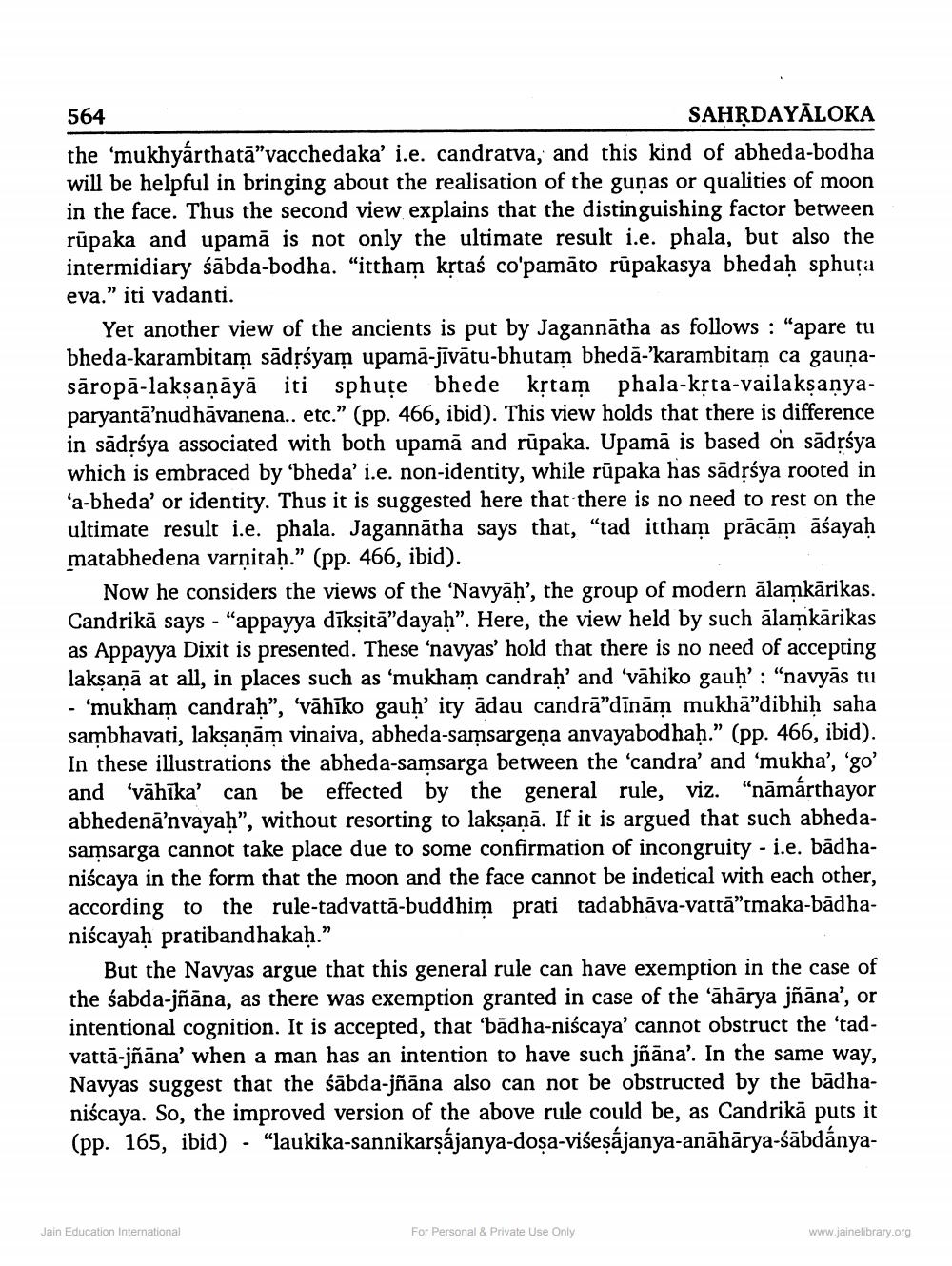________________
564
SAHRDAYĀLOKA the 'mukhyárthatā"vacchedaka' i.e. candratva, and this kind of abheda-bodha will be helpful in bringing about the realisation of the guņas or qualities of moon in the face. Thus the second view explains that the distinguishing factor between rūpaka and upamā is not only the ultimate result i.e. phala, but also the intermidiary śābda-bodha. "ittham krtaś co'pamāto rūpakasya bhedah sphuta eva.” iti vadanti.
Yet another view of the ancients is put by Jagannātha as follows : "apare tu bheda-karambitam sādrśyam upamā-jivātu-bhutam bheda-karambitam ca gaunasāropā-lakṣaṇāyā iti sphuțe bhede kệtam phala-ksta-vailaksanyaparyantā’nudhāvanena.. etc.” (pp. 466, ibid). This view holds that there is difference in sādrsya associated with both upamā and rūpaka. Upamā is based on sādrsya which is embraced by 'bheda' i.e. non-identity, while rūpaka has sādrśya rooted in 'a-bheda' or identity. Thus it is suggested here that there is no need to rest on the ultimate result i.e. phala. Jagannātha says that, “tad ittham prācām āśayah matabhedena varņitaḥ.” (pp. 466, ibid).
Now he considers the views of the 'Navyāh', the group of modern alamkārikas. Candrikā says - "appayya dīksitā"dayah”. Here, the view held by such ālamkārikas as Appayya Dixit is presented. These 'navyas' hold that there is no need of accepting laksana at all, in places such as 'mukham candrah' and 'vāhiko gauh' : "navyās - ‘mukham candrah”, vāhīko gauņ' ity adau candrā”dīnām mukhā”dibhiḥ saha sambhavati, laksaņām vinaiva, abheda-samsargeņa anvayabodhah.” (pp. 466, ibid). In these illustrations the abheda-samsarga between the 'candra' and 'mukha', 'go' and 'vähīka' can be effected by the general rule, viz. "nāmárthayor abhedenā'nvayah”, without resorting to laksanā. If it is argued that such abhedasamsarga cannot take place due to some confirmation of incongruity - i.e. badhaniscaya in the form that the moon and the face cannot be indetical with each other, according to the rule-tadvattā-buddhim prati tadabhāva-vattā”tmaka-badhaniścayaḥ pratibandhakah.”
But the Navyas argue that this general rule can have exemption in the case of the śabda-jñāna, as there was exemption granted in case of the 'āhārya jñāna', or intentional cognition. It is accepted, that 'badha-niscaya' cannot obstruct the 'tadvattā-jñāna' when a man has an intention to have such jñāna'. In the same way, Navyas suggest that the śābda-jñāna also can not be obstructed by the bādhaniścaya. So, the improved version of the above rule could be, as Candrikā puts it (pp. 165, ibid) - "laukika-sannikarsájanya-dosa-viśesájanya-anāhārya-śābdánya
Jain Education International
For Personal & Private Use Only
www.jainelibrary.org




